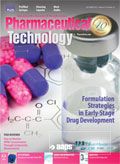Lab Line for Developing Drug Implant Technology
The Thermo Scientific Pharma mini implant line is an integrated solution built around the Thermo Scientific Pharma mini HME twin-screw micro compounder.

The Thermo Scientific Pharma mini implant line is an integrated solution for polymer-based drug implant development and production using hot-melt extrusion (HME). Built around the Thermo Scientific Pharma mini HME twin-screw micro compounder, the continuous, automated production line minimizes formulation development time. The line allows contract research and manufacturing organizations to develop and optimize small-scale formulations before engaging in larger-scale production.
Components of the line include a containment valve to add the API and the polymer, designed to protect the operator from exposure to the API and prevent contamination of the API; a gravimetric feeder to deliver the API/polymer into the micro compounder for heating and mixing before the melt is extruded through a die that creates a continuous filament; new bi-axial lasers that measure the thickness or diameter of the filament to adjust the stretching or “take-off” speed of the conveyor belt; and proprietary equipment that cuts the filament to a desired implant length while maintaining “roundness” without deforming the implant shape.

Drug Solutions Podcast: A Closer Look at mRNA in Oncology and Vaccines
April 30th 2024In this episode fo the Drug Solutions Podcast, etherna’s vice-president of Technology and Innovation, Stefaan De Koker, discusses the merits and challenges of using mRNA as the foundation for therapeutics in oncology as well as for vaccines.
Drug Solutions Podcast: Applying Appropriate Analytics to Drug Development
March 26th 2024In this episode of the Drug Solutions Podcast, Jan Bekker, Vice President of Business Development, Commercial and Technical Operations at BioCina, discusses the latest analytical tools and their applications in the drug development market.